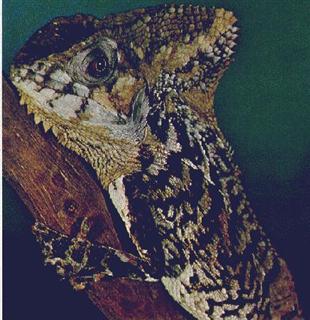Helmeted Iguana - Forest
Forest Chameleon Scientific Name: Corytophanes cristatus
Mon, 28th April, 2025 - 9:38 am GMT
Sponsor Ads:

Alternative Name
Forest Chameleon Scientific Name: Corytophanes cristatusBasic Info
Mature Forest Helmeted Iguanas will grow to approximately 34 centimeters (14 inches) in length. Their coloring ranges from brown to gray, with some light and dark coloration as well. Males and females can be distinguished visually, though some report the distinction to be difficult. On average, females have a noticeably smaller helmet than males.
Health
Forest Helmeted Iguanas should be kept in large enclosures that allow room for climbing, since these lizards are arboreal by nature. Provide full spectrum UV lighting for about 13 hours per day. Ambient daytime temperatures should be about 85 degrees Fahrenheit with a basking area in the low to mid 90s. Nightime temperatures should be 75 - 80 degrees Fahrenheit. Humidity is also important, and levels should be kept high. Water should be supplied by misting and in a water bowl. Helmeted Iguanas have a varied diet in the wild, and can be fed a variety of foods in captivity. Some good choices include arthropods, crickets, earthworms, lizards, mice (pinkies and fuzzies), and spiders. It is also a good idea to add a multivitamin supplement and calcium to their diet. Breeding The Forest Helmeted Iguana has no set breeding period, and has been observed to breed throughout the year. After mating, females lay anywhere from as few as 6 eggs to as many as 11 in a single clutch. Eggs are usually laid in moist areas. After gestation, babies are born measuring between three and four inches in length.Habitat
Southern regions of Mexico, to Northeastern Columbia.Behavior
The Forest Helmeted Iguana is also known as the "Forest Chameleon", but it is not a true chameleon at all. Forest Helmeted Iguanas are arboreal lizards that prefer tropical rainforest habitats. Forest Forest Helmeted Iguanas are well known for their primary defense mechanism, which is to "play dead". They will often appear utterly lifeless in the face of danger.Origin
Mexico and Central AmericaHistory
The Forest Helmeted Iguana is native to Mexico and Central America, and is most common in the Southern regions of Mexico, to Northeastern Columbia.Common Foods
N/ASponsor Ads:
"An army may march great distances without distress, if it marches through country where the enemy is not." -- Sun Tzu, The Art of War
Helmeted Iguana - Forest
Coded by: BGID® | ALL RIGHTS RESERVED Copyright © 2000-2025
Disclaimer | Privacy | Report Errors / Contact | Credits








 President of the United States of America - Real Estate mogul, Pageant owner and now one of the most controversial men in political history.
President of the United States of America - Real Estate mogul, Pageant owner and now one of the most controversial men in political history.  Politician, US Vice President and President of the USA - Joseph Robinette Biden Jr.
Politician, US Vice President and President of the USA - Joseph Robinette Biden Jr.  versus
versus  Russia: 'The Evil Empire'? Are they all that bad or is it just the USA trying to portray Russia as bad because they are a world power with land bigger and a society very different from the USA ideal?
Russia: 'The Evil Empire'? Are they all that bad or is it just the USA trying to portray Russia as bad because they are a world power with land bigger and a society very different from the USA ideal?  Global warming has been in and out as the "latest" hot topic for many years. It is, according to modern scientists, the result of man-made industrial pollutants, clearing forested areas, agriculture, etc. But now they are thinking it started way before the Industrial Revolution...
Global warming has been in and out as the "latest" hot topic for many years. It is, according to modern scientists, the result of man-made industrial pollutants, clearing forested areas, agriculture, etc. But now they are thinking it started way before the Industrial Revolution... 
 Corona virus
Corona virus 
 Users with wide screen monitors can benefit from more content on every page.
Users with wide screen monitors can benefit from more content on every page.